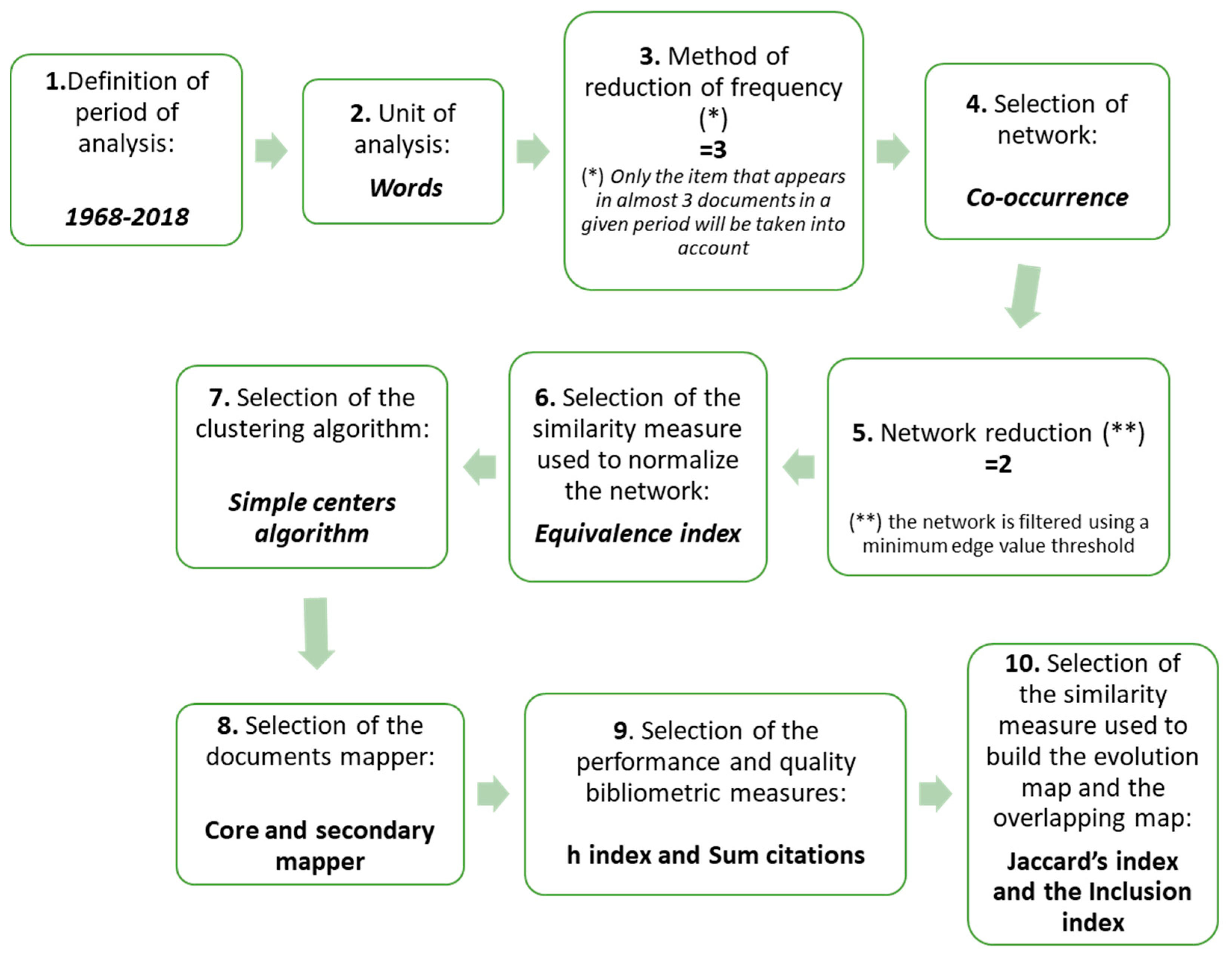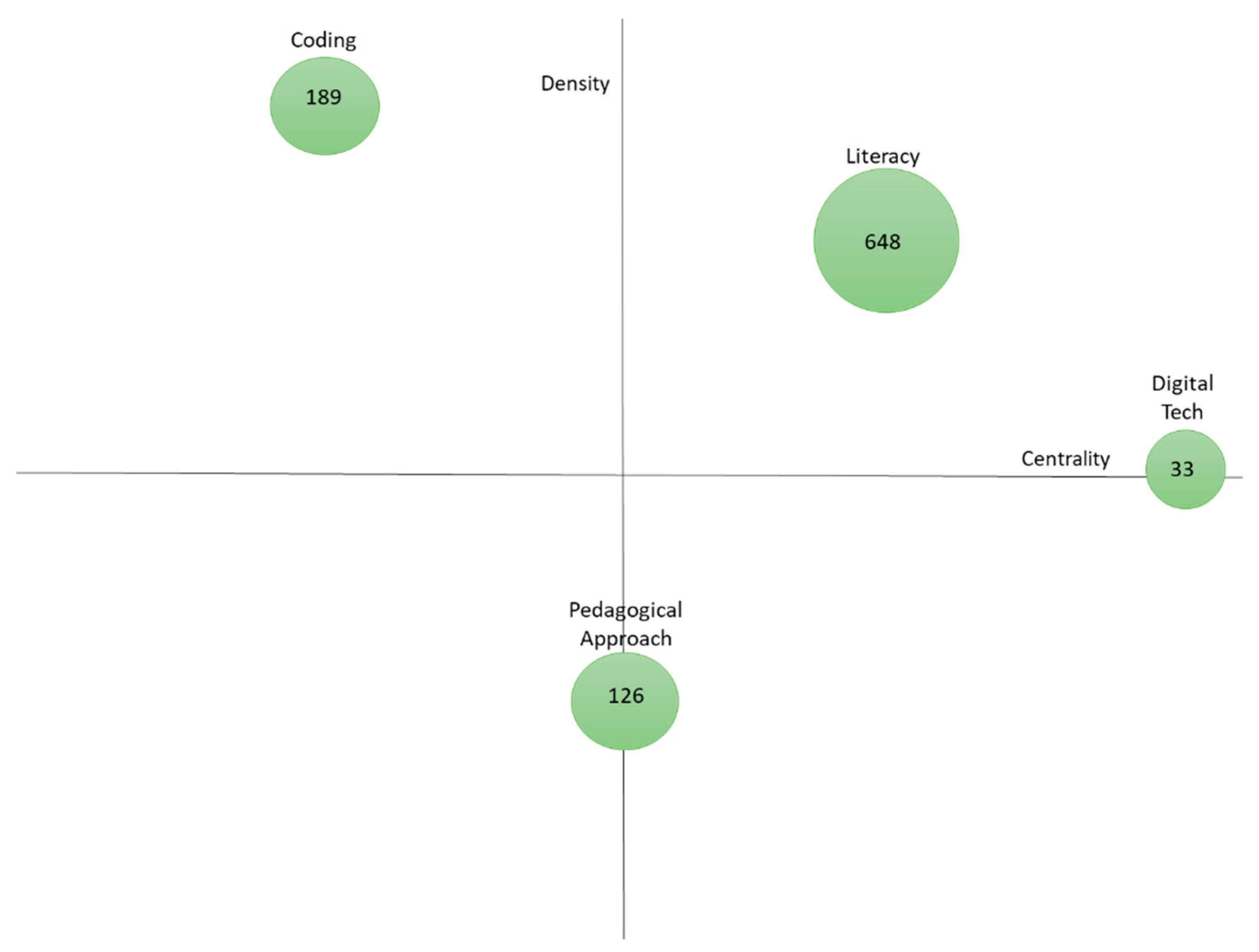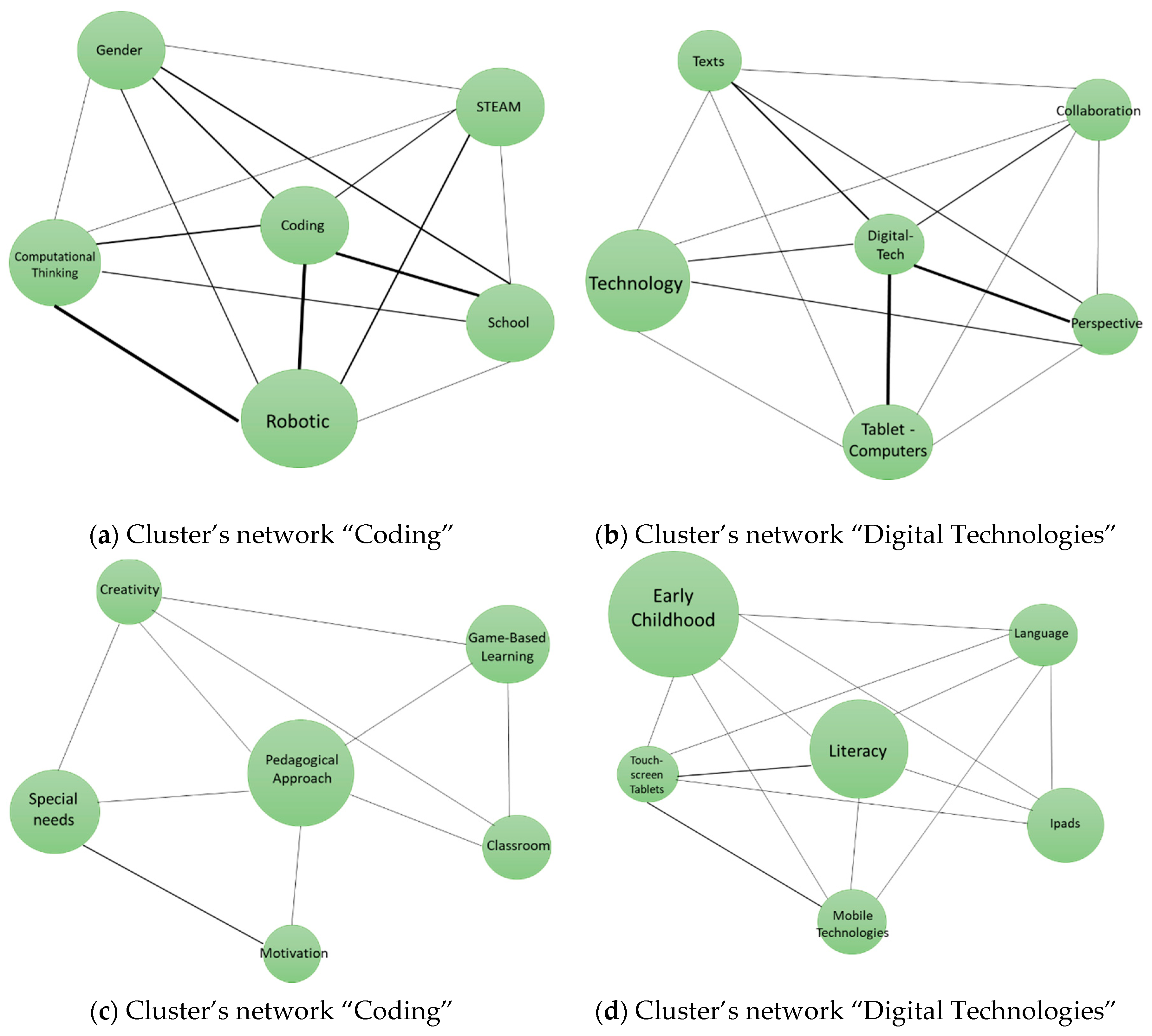Tangible Technologies for Childhood Education: A Systematic Review
Abstract
1. Introduction
- (1)
- What tangible technologies have been used in childhood education?
- (2)
- What has been the educational use of tangible technologies in childhood?
- (3)
- What pedagogical approach is behind of tangible technologies in childhood education?
2. Method
- Quality: Articles peer-review and index (in the Web of Science (WoS): Articles were identified by searching in the Web of Science (WoS). The indexes included in the search were SCI-EXPANDED, SSCI, A&HCI, CPCI-S, CPCI-SSH, BKCI-S, BKCI-SSH, and ESCI.
- Date: We decided to study from 1968 because the Dynabook [17] was created by Alan Kay: the first tablet for children. So, the studies selected in this study were published from 1968 to 2018.
- Language (English): Databases were filtered and limited by English language and peer reviewed journals.
- Research area: The first redefining included only the specific documents of the research area: Education & Educational Research.
- Type of documents: the type of the document selected was “articles”.
- Domain: The keywords used in the search were tangible interfaces, gestural interfaces, sensors, robotics, tablets, young children, infancy, and childhood.
3. Results
3.1. Science Mapping Analysis (Clustering)
3.2. Analysis of Documents
3.2.1. Digital Technologies
3.2.2. Coding
3.2.3. Literacy
3.2.4. Pedagogical Approach
3.2.5. Other Findings
4. Conclusions
Author Contributions
Funding
Conflicts of Interest
References
- Blackwell, C.K.; Lauricella, A.R.; Wartella, E. The influence of TPACK contextual factors on early childhood educators’tablet computer use. Comput. Educ. 2016, 98, 57–69. [Google Scholar] [CrossRef]
- Ishii, H.; Ullmer, B. Tangible Bits: Towards Seamless Interfaces between People, Bits and Atoms. 1997. Available online: http://gtubicomp2013.pbworks.com/w/file/fetch/65131525/ishii-tangible-bits-chi1997.pdf (accessed on 22 May 2019).
- Read, J.C.; Markopoulos, P.; Parés, N.; Hourcade, J.P.; Antle, A.N. Child computer interaction. In Proceedings of the Twenty-Sixth Annual CHI Conference Extended Abstracts on Human Factors in Computing Systems (CHI ’08), Florence, Italy, 5–10 April; ACM Press: New York, NY, USA, 2008; p. 2419. [Google Scholar]
- Hourcade, J.P. Child-Computer Interaction. 2015. Available online: http://homepage.cs.uiowa.edu/~hourcade/book/child-computer-interaction-first-edition.pdf (accessed on 22 May 2019).
- Turkle, S. Alone Together: Why We Expect More from Technology and Less from Each Other; Basic Books: New York, NY, USA, 2017; ISBN 9780465093656. [Google Scholar]
- Granic, I.; Lobel, A.; Engels, R.C. The benefits of playing video games. Am. Psychol. 2014, 69, 66–78. [Google Scholar] [CrossRef] [PubMed]
- Zuckerman, O.; Arida, S.; Resnick, M. Extending tangible interfaces for education. In Proceedings of the SIGCHI Conference on Human Factors in Computing Systems (CHI ’05), Portland, OR, USA, 2–7 April 2005; ACM Press: New York, NY, USA, 2005; p. 859. [Google Scholar]
- Nácher-Soler, V.E.; García Sanjuan, F.; Jaén Martínez, F.J. Game Technologies for Kindergarten Instruction: Experiences and Future Challenges. In Proceedings of the II Congreso de la Sociedad Española para las Ciencias del Videojuego (CoSECiVi 2015), Barcelona, Spain, 24 June 2015. [Google Scholar]
- Neumann, M.M. An examination of touch screen tablets and emergent literacy in Australian pre-school children. Aust. J. Educ. 2014, 58, 109–122. [Google Scholar] [CrossRef]
- Antle, A.N. The CTI framework. In Proceedings of the 1st International Conference on Tangible and Embedded Interaction (TEI ’07), Baton Rouge, LA, USA, 15–17 February 2007; ACM Press: New York, NY, USA, 2007; p. 195. [Google Scholar]
- Antle, A.N.; Wise, A.F. Getting Down to Details: Using Theories of Cognition and Learning to Inform Tangible User Interface Design. Interact. Comput. 2013, 25, 1–20. [Google Scholar] [CrossRef]
- Markova, M.S.; Wilson, S.; Stumpf, S. Tangible User Interfaces for Learning; 2012. Available online: http://openaccess.city.ac.uk/4353/ (accessed on 22 May 2019).
- Marshall, P. Do tangible interfaces enhance learning? In Proceedings of the 1st International Conference on Tangible and Embedded Interaction (TEI ’07), Baton Rouge, LA, USA, 15–17 February 2007; ACM Press: New York, NY, USA; p. 163. [Google Scholar]
- Papert, S. Mindstorms: Children, Computers, and Powerful Ideas; Basic Books: New York, NY, USA, 1980; ISBN 0465046274. [Google Scholar]
- Read, J.C.; Bekker, M.M. The nature of child computer interaction. In Proceedings of the 25th BCS Conference Human Computer Interaction, Newcastle Upon Tyne, UK, 4–8 July 2011; pp. 163–170. [Google Scholar]
- Tsafnat, G.; Glasziou, P.; Choong, M.K.; Dunn, A.; Galgani, F.; Coiera, E. Systematic review automation technologies. Syst. Rev. 2014, 3, 74. [Google Scholar] [CrossRef]
- Kay, A. Review: Dynabooks: Past, Present, and Future. Libr. Q. Inf. Community Policy 2000, 70, 385–395. [Google Scholar]
- Martínez, M.A.; Cobo, M.J.; Herrera, M.; Herrera-Viedma, E. Analyzing the Scientific Evolution of Social Work Using Science Mapping. Res. Soc. Work Pract. 2015, 25, 257–277. [Google Scholar] [CrossRef]
- de la Guía, E.; Camacho, V.L.; Orozco-Barbosa, L.; Luján, V.M.; Penichet, V.M.; Pérez, M.L. Introducing IoT and Wearable Technologies into Task-Based LanguageLearning for Young Children. IEEE Trans. Learn. Technol. 2016, 9, 366–378. [Google Scholar] [CrossRef]
- Marsh, J. The Internet of Toys: A Posthuman and Multimodal Analysis of ConnectedPlay. Teach. Coll. Rec. 2017, 119, 120305. [Google Scholar]
- Gülay Ogelman, H.; Güngör, H.; Körükçü, Ö.; Erten Sarkaya, H. Examination of the relationship between technology use of 5–6 year-old children and their social skills and social status. Early Child Dev. Care 2018, 188, 168–182. [Google Scholar] [CrossRef]
- Edwards, S.; Nolan, A.; Henderson, M.; Mantilla, A.; Plowman, L.; Skouteris, H. Young children’s everyday concepts of the internet: A platform for cyber-safety education in the early years. Br. J. Educ. Technol. 2018, 49, 45–55. [Google Scholar] [CrossRef]
- Mertala, P. Fun and games—Finnish children’s ideas for the use of digital media inpreschool. Nord. J. Digit. Lit. 2016, 11, 207–226. [Google Scholar] [CrossRef]
- Kanaki, K.; Kalogiannakis, M. Introducing fundamental object-oriented programming concepts in preschool education within the context of physical science courses. Educ. Inf. Technol. 2018, 23, 2673–2698. [Google Scholar] [CrossRef]
- Elkin, M.; Sullivan, A.; Bers, M.U. Programming with the KIBO Robotics Kit in Preschool Classrooms. Comput. Sch. 2016, 33, 169–186. [Google Scholar] [CrossRef]
- Alhinty, M. International Journal of Emerging Technologies in Learning; Kassel University Press: Kassel, Germany, 2015; Volume 10. [Google Scholar]
- Lu, Y.-H.; Ottenbreit-Leftwich, A.T.; Ding, A.-C.; Glazewski, K. Experienced iPad-Using Early Childhood Teachers: Practices in theOne-to-One iPad Classroom. Comput. Sch. 2017, 34, 9–23. [Google Scholar] [CrossRef]
- Neumann, M.M. Using tablets and apps to enhance emergent literacy skills in youngchildren. Early Child. Res. Q. 2018, 42, 239–246. [Google Scholar] [CrossRef]
- Reeves, J.L.; Gunter, G.A.; Lacey, C. Mobile Learning in Pre-Kindergarten: Using Student Feedback to InformPractice. Educ. Technol. Soc. 2017, 20, 37–44. [Google Scholar]
- Neumann, M.M.; Finger, G.; Neumann, D.L. A Conceptual Framework for Emergent Digital Literacy. Early Child. Educ. J. 2017, 45, 471–479. [Google Scholar] [CrossRef]
- Kervin, L. Powerful and playful literacy learning with digital technologies. Aust. J. Lang. Lit. 2016, 39, 64–73. [Google Scholar]
- Neumann, M.M.; Neumann, D.L. The use of touch-screen tablets at home and pre-school to foster emergent literacy. J. Early Child. Lit. 2017, 17, 203–220. [Google Scholar] [CrossRef]
- Patchan, M.M.; Puranik, C.S. Using tablet computers to teach preschool children to write letters: Exploring the impact of extrinsic and intrinsic feedback. Comput. Educ. 2016, 102, 128–137. [Google Scholar] [CrossRef]
- Schacter, J.; Shih, J.; Allen, C.M.; DeVaul, L.; Adkins, A.B.; Ito, T.; Jo, B. Math Shelf: A Randomized Trial of a Prekindergarten Tablet Number SenseCurriculum. Early Educ. Dev. 2016, 27, 74–88. [Google Scholar] [CrossRef]
- Miller, E.B.; Warschauer, M. Young children and e-reading: Research to date and questions for the future. Learn. Media Technol. 2014, 39, 283–305. [Google Scholar] [CrossRef]
- Neumann, M.M. Young children’s use of touch screen tablets for writing and reading athome: Relationships with emergent literacy. Comput. Educ. 2016, 97, 61–68. [Google Scholar] [CrossRef]
- Dunn, J.; Gray, C.; Moffett, P.; Mitchell, D. ‘It’s more funner than doing work’: Children’s perspectives on usingtablet computers in the early years of school. Early Child Dev. Care 2018, 188, 819–831. [Google Scholar] [CrossRef]
- Kucirkova, N. IRPDA framework for guiding design-based research for iPad apps. Br. J. Educ. Technol. 2017, 48, 598–610. [Google Scholar] [CrossRef]
- Sullivan, A.; Bers, M.U. Girls, Boys, and Bots: Gender Differences in Young Children’s Performance on Robotics and Programming Tasks. J. Inf. Technol. Educ. Pract. 2016, 15, 145–165. [Google Scholar] [CrossRef]
- Moore, H.C.; Adair, J.K. “I’m Just Playing iPad”: Comparing Prekindergarteners’ and Preservice Teachers’ Social Interactions While Using Tablets for Learning. J. Early Child. Teach. Educ. 2015, 36, 362–378. [Google Scholar] [CrossRef]
- Arnott, L.; Grogan, D.; Duncan, P. Lessons from using iPads to understand young children’s creativity. Contemp. Issues Early Child. 2016, 17, 157–173. [Google Scholar] [CrossRef]
- Fleer, M. The demands and motives afforded through digital play in early childhood activity settings. Learn. Cult. Soc. Interact. 2014, 3, 202–209. [Google Scholar] [CrossRef]
- Price, S.; Jewitt, C.; Crescenzi, L. The role of iPads in pre-school children’s mark making development. Comput. Educ. 2015, 87, 131–141. [Google Scholar] [CrossRef]
- Bers, M.U.; Flannery, L.; Kazakoff, E.R.; Sullivan, A. Computational thinking and tinkering: Exploration of an early childhoodrobotics curriculum. Comput. Educ. 2014, 72, 145–157. [Google Scholar] [CrossRef]
- Alhinty, M. English-Language Learning at their Fingertips: How Can Teachers UseTablets to Teach EFL Children? Int. J. Mob. Blended Learn. 2015, 7, 45–63. [Google Scholar] [CrossRef]
- Bers, M.U.; González-González, C.; Armas-Torres, M.B. Coding as a playground: Promoting positive learning experiences in childhood classrooms. Comput. Educ. 2019, 138, 130–145. [Google Scholar] [CrossRef]
- Neumann, M.M. Parent scaffolding of young children’s use of touch screen tablets. Early Child Dev. Care 2018, 188, 1652–1662. [Google Scholar] [CrossRef]



| Task | Description | Phase |
|---|---|---|
| 1. Formulation of review question | Identification of tangible technologies, educational uses and main findings in childhood education | Preparation |
| 2. Definition of the protocol | Method and tools (WoS/SciMat/Mendeley) | |
| 3. Definition search strategy | Databases (WoS) and keywords | |
| 4. Search | Find relevant citations (WoS) | Appraisal |
| 5. Clustering | Extract relevant terms and categories from documents (SciMat) | |
| 6. Refine and organize | Extract most relevant citations (WoS) and organize references (Mendeley) | |
| 7. Abstracts | Screen abstracts, remove irrelevant references | |
| 8. Full texts | Read full texts and extract data associated to the categories of analysis | |
| 9. Data | Analysis and synthesis of extracted data | Synthesis |
| 10. Review | Final report |
| Cluster 1 | Centrality | Centrality Range | Density | Density Range |
|---|---|---|---|---|
| Coding | 24.88 | 0.25 | 46.81 | 1 |
| Digital-Technologies | 41.26 | 1 | 20.21 | 0.5 |
| Literacy | 38.76 | 0.75 | 38.07 | 0.75 |
| Pedagogical Approach | 35.06 | 0.5 | 11.55 | 0.25 |
| References | Technology | Sample | Research method | |
|---|---|---|---|---|
| Cluster: Digital Technologies—Research Questions: 1 | ||||
| [19] | de la Guia, Lopez Camacho, Orozco-Barbosa Luis and Brea Lujan, Penichet, & Lozano Perez, 2016 | IoT/wearable | Children: 15 Age: 7.33 (mean) | Survey/Observation |
| [20] | Marsh, 2017 | Tablets | Parents (2000) of children aged 0–5 years Children: Classroom/A case | Survey/Observation |
| [21] | Gülay Ogelman, Güngör, Körükçü, & Erten Sarkaya, 2018 | Television, portable computers, tablets and smartphones | 162 children aged between 5 and 6 years old | Questionnaires |
| [22] | Edwards et al., 2018 | Tablets | Children: 70 aged between 4 and 5 years. | Pilot experimental study |
| [23] | Mertala, 2016 | Computers, tablets, cameras, television | Children: 103 aged 5–6 years old from 5 kindergartens. | Children’s drawings and tell conversation method (interviews) |
| Cluster: Coding—Research Questions: 2 | ||||
| [24] | Kanaki & Kalogiannakis, 2018 | Smartphones | Children aged between 4–8 years old. | Observation |
| [25] | Elkin, Sullivan, & Bers, 2016 | Robots | Children: 64 aged 3–5 years old from 7 classrooms. | PTD/Observation |
| [6] | Granic et al., 2014 | Robots | Three teachers and 53 children aged between 4–6 years old. | Iterative testing, analysis, and refinement of an intervention |
| [26] | Alhinty, 2015b | Tablets | 22 children | Qualitative research (participant observation, focus groups, semistructured interviews and blogging) |
| Cluster: Literacy—Research Questions: 2 | ||||
| [27] | Lu, Ottenbreit-Leftwich, Ding, & Glazewski, 2017 | Tablets | 4 teachers | Observation and Interviews |
| [28] | Neumann, 2018b | Tablets | Children: 48 aged 2–5 years | Pre–post-test randomized controlled study |
| [29] | Reeves, Gunter, & Lacey, 2017 | Tablets | Children: 28 (4–5 years old) from 2 pre-kindergarten classrooms | VPK Assessment, two groups (experimental and control) Florida Department of Education assessment (FLDOE). |
| [30] | Neumann, Finger, & Neumann, 2017 | E-books and digital games | - | Literature review |
| [31] | Kervin, 2016 | Tablets | 6 families (12 parents and 7 preschooler children) | Qualitative (semistructured interviews and observations) |
| [32] | Neumann & Neumann, 2017 | Tablets | - | Literature review |
| [33] | Patchan & Puranik, 2016 | Tablets | 54 preschool children (aged 41–65 months) in 21 small groups | Two individual assessments: letter naming and letter writing |
| [34] | Schacter et al., 2016 | Tablets | Children = 100 | Randomized controlled trial |
| [35] | Miller & Warschauer, 2014 | Tablets | - | Literature review |
| [36] | Neumann, 2016 | Tablets | 57 children aged between 2–4 years old. | Emergent literacy assessment |
| [9] | Neumann, 2014 | Tablets | Parents 109 Children 3–5 years old | Assessment of children in their preschool and a home questionnaire for parents. |
| [37] | Dunn, Gray, Moffett, & Mitchell, 2018 | Tablets | 6 children of 5 schools | Focus group |
| Cluster: Pedagogical Approach. Research Questions: 3 | ||||
| [38] | Kucirkova, 2017 | Tablets | 3 Teachers | Codesign |
| [1] | Blackwell, Lauricella, & Wartella, 2016b | Tablets | 411 preschool educators serving 3–5-year-olds in school-based, center-based, and Head Start preschool programs | Survey |
| [9] | Neumann, 2014 | Tablets | 55 parents of children (Mena = 3.49 years) | Observation/Video recording/Questionnaire |
| Cluster: Other. Research Questions: 1, 2, 3 | ||||
| [39] | Sullivan & Bers, 2016b | Robots | 45 children (4–7 years old) | Qualitative interviews (pre–post), Solve-its |
| [40] | Moore & Adair, 2015 | Tablets | Pre-kindergarteners and preservice teachers in early childhood education coursework | Qualitative (Observation) |
| [41] | Arnott, Grogan, & Duncan, 2016 | Tablets | Children aged 3–5 years old | Video diaries/Observation |
| [42] | Fleer, 2014 | Tablets | 25 children, range of 3.3 to 4.4; mean of 3.8 years. | Video observation |
| [43] | Price, Jewitt, & Crescenzi, 2015 | Tablets | 11 children of 4 years old | Video observation |
© 2019 by the authors. Licensee MDPI, Basel, Switzerland. This article is an open access article distributed under the terms and conditions of the Creative Commons Attribution (CC BY) license (http://creativecommons.org/licenses/by/4.0/).
Share and Cite
González-González, C.S.; Guzmán-Franco, M.D.; Infante-Moro, A. Tangible Technologies for Childhood Education: A Systematic Review. Sustainability 2019, 11, 2910. https://doi.org/10.3390/su11102910
González-González CS, Guzmán-Franco MD, Infante-Moro A. Tangible Technologies for Childhood Education: A Systematic Review. Sustainability. 2019; 11(10):2910. https://doi.org/10.3390/su11102910
Chicago/Turabian StyleGonzález-González, Carina S., María D. Guzmán-Franco, and Alfonso Infante-Moro. 2019. "Tangible Technologies for Childhood Education: A Systematic Review" Sustainability 11, no. 10: 2910. https://doi.org/10.3390/su11102910
APA StyleGonzález-González, C. S., Guzmán-Franco, M. D., & Infante-Moro, A. (2019). Tangible Technologies for Childhood Education: A Systematic Review. Sustainability, 11(10), 2910. https://doi.org/10.3390/su11102910







